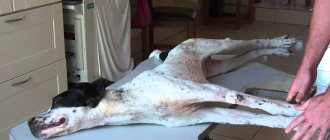Vomiting in a dog is a defense mechanism of the body. It occurs reflexively. There can be many reasons why such an unpleasant sensation occurs. It occurs both as a result of banal poisoning and due to serious disorders in the animal’s body. What dog behavior should you be especially wary of?
Condition preceding vomiting
Unfortunately, our pets cannot speak and it is impossible to understand what they are feeling. This can only be determined by the behavior of the animal and its appearance.
- Typically, vomiting in a dog begins with nausea and the following symptoms:
- The dog licks his lips frequently;
- Does not approach the plate of food or drink water;
- Due to excessive salivation, he constantly swallows saliva;
- The dog is in a restless state, rushing around the rooms, not finding a place for itself;
- The stomach growls;
- Dyspeptic disorders occur: diarrhea or constipation.
Such similar phenomena as vomiting and regurgitation leave animal owners confused. In the second case, food does not reach the stomach, and it is removed from the esophagus. And when vomiting, food is exposed to digestive enzymes, so it looks like a yellow or yellow-green gruel.
Symptoms
The state of nausea causes anxiety in the dog. She may run in circles, sniff and lick the floor, hide under furniture or in a corner. The animal is drooling, although nausea is not necessarily accompanied by vomiting. It is not necessarily a harbinger of disease. The pet can burp several times, protecting the walls from digestion by the stomach itself. This regurgitation often occurs when food is completely digested. You just need to observe your pet before drawing conclusions about a specific disease.
Causes of mucus nausea
Nausea from mucus can be caused by various reasons, ranging from the most harmless to symptoms of damage to the body by a dangerous illness.
Causes of nausea:
- Digestive problems. The dog's rapid absorption of pieces of food does not allow the food to be completely digested, and undigested food often comes back out along with mucus.
- Fatty, heavy foods can provoke the release of mucus.
- Trying to clear your stomach of swallowed inedible objects, such as pieces of plastic or rubber from toys.
- Poor quality or spoiled food can cause a protective reaction in the body in the form of vomiting to cleanse it.
- Viral infection (leptospirosis, plague, enteritis) is sometimes accompanied by vomiting.
- Poisoning with toxic substances, such as rat poison.
- Stress, which, in addition to fear, fear, can be caused by physical fatigue or solar overheating.
- Infection with worms.
- Malignant tumors in the gastrointestinal tract, liver or gallbladder of the pet.
- An ixodid tick bite and infection with a serious disease - babesiosis (piroplasmosis).
- Digestive diseases: gastritis, ulcers, inflammation of the gallbladder.
- Infectious hepatitis.
Vomiting as a defense mechanism
Animals are sensitive to the needs of their bodies. If a dog greedily eats more than normal, the stomach will soon get rid of the excess amount of food. Vomiting occurs due to illness. For example, bitches feed their cubs poorly digested food, regurgitating it little by little.
Take the Attention Test! Find 10 differences! (click right here!)
Find the answer Are you bothered by some problem or question? Enter “Breed” or “Name of the problem” into the form, press Enter and you will find out everything about the issue that interests you.
You should monitor your pet when vomiting becomes periodic. The presence of diseases of the stomach or intestines cannot be excluded. Often white vomit is a protective mechanism that cleanses the pet’s body of toxins during viral diseases or poisoning.
Yellow vomit in a dog
If a dog vomits yellow foam , just like when vomiting white foam, most often indicates an empty stomach of the animal. Vomit gets a yellowish tint when bile and gastric juice mix. This is a natural phenomenon that occurs reflexively directly during a meal or shortly before feeding. Vomiting with yellow foam means that the dog's food portion was not enough. However, an isolated case is not an alarming symptom. If the vomit does not contain pieces of food, a visit to the veterinarian is not required. There is also no need to worry about treating a dog with yellow foamy vomiting if the vomiting occurred after the dog ate grass while walking. As we wrote earlier, in this way the stomach is cleansed of the remnants of undigested food. Look at your pet's diet. Most likely, his diet includes a large amount of cereals - buckwheat, rice, oatmeal and pearl barley. The simplest and only correct solution in this situation would be to reduce the amount of cereal and refuse food that is not intended for dogs. Remember, you cannot “feed the dog from the table.” The dog's stomach is different from the human stomach and requires separate nutrition. If the rest of your pet’s behavior has not changed, he is active and does not show signs of anxiety, we can assume that his health is not in danger.
In some cases, a dog vomits bile if parasites have taken up residence in its body. Diarrhea and vomiting of bile in a dog can also indicate such a dangerous disease as infectious or viral hepatitis. Additional signs of this disease will be a constantly elevated body temperature and a deterioration in the general health of your pet. Remember that intoxication leads the animal’s body to dehydration, which can even lead to death.
Pathological vomiting
When the disease occurs, the dog first vomits white foam, then there is a general deterioration in health. During the period of illness, vomiting ceases to play the role of a protective mechanism; it dehydrates and depletes her body. An alarming symptom, especially for small puppies, is frequent vomiting. It can occur after feeding and drinking, or on an empty stomach. The color of the vomit may change to gray, black or red. You should immediately contact a veterinary clinic; this condition can lead to death of the animal.
Vomiting from a tick in a dog
A tick bite can also cause an animal to vomit. Piroplasmosis is a seasonal spring-autumn disease, the causative agent of which is the protozoan blood parasite Babesia. The single-celled parasite enters the animal's blood through a tick bite and begins to destroy red blood cells. The principle of infecting an animal is very simple:
- the tick awaits its prey in the grass, on tree branches and even on the ground;
- after it has dug into the skin, when it bites, it injects saliva, and with it microscopic parasites - piroplasms (babesia) - enter the bloodstream;
- Parasites multiply in the animal's body, destroying red blood cells.
The incubation period of the disease lasts from 2 days to 2 weeks. Dogs of all breeds and ages suffer from piroplasmosis; young and elderly animals suffer the most. If, along with vomiting foam, your dog develops yellow diarrhea , lethargy, apathy, loss of appetite, rapid breathing, increased body temperature, pale mucous membranes, and urine becomes dark in color, your pet will most likely be prescribed treatment for piroplasmosis. Only a veterinary clinic specialist can make a final diagnosis for your pet based on examination, medical history and test results. Remember, if the dog does not receive treatment, the animal may die 4-5 days after the first symptoms of the disease appear!
A number of diseases
It is possible to establish the exact cause of vomiting from previously studied information about the diseases they have suffered.
Typical diseases include:
- Intoxication of various origins;
- Intestinal obstruction;
- A foreign body that has entered the gastrointestinal tract;
- Pancreatitis and colitis;
- Diseases of the central nervous system;
- Traumatic brain injuries;
- Hydrocephalic syndrome;
- Brain tumors;
- Oncological diseases;
- Hepatitis, plague, enteritis;
- Volvulus;
- Lentospirosis and helminthiases;
- Coronavirus infection.
The above is a partial list of diseases that cause vomiting. A manifestation of gastritis will be frequent periodic vomiting of white mucus. Violation of the diet and food composition sometimes causes gastritis. Frequent vomiting is a clear sign of intestinal obstruction, severe intoxication, or indicates a foreign object in the pet’s stomach. For an accurate diagnosis, veterinarians advise recording how many times, in what volume and what the dog vomited.
Damage to the brain and central nervous system causes vomiting. Traumatic brain injuries, hydrocephalus, brain tumors, heat and sunstroke, and seasickness will be the causes of vomiting. Impaired liver function, kidney function, parasitic diseases, drug overdose are added to the above reasons.
About the vomiting mechanism
Vomiting in dogs is not so rare as to be considered something out of the ordinary. An animal may vomit completely suddenly, but this does not mean that you need to panic. This may be a completely natural physiological reaction of the body: protection against increased acidity of gastric juices, rejection of a foreign object, etc. Foam when vomiting appears as a result of the reaction of air with mucus. Mucus is formed in the stomach to protect its walls from being corroded by gastric acids. Like all other reflexes, gag is provoked by nervous mechanisms that arise in the center of the nervous system or in the periphery through receptors in the abdominal or thoracic region. Nerve endings give a signal that “turns on” the mechanism of muscle contractions that cause vomiting.
The pet cannot warn the owner that he will soon vomit. But there are very clear behavioral signs that precede vomiting:
- As a rule, the dog feels sick and refuses food and water;
- excessive salivation and frequent licking of the muzzle;
- restless behavior, chaotic movements;
- rumbling in the stomach and belching.
Contacting a veterinarian
A single regurgitation in a pet that is not caused by intoxication is not a reason for treatment. Alarming signs of intoxication will be general lethargy, drowsiness, or when the animal refuses to eat. In the future, the sick pet may stop getting up, pay attention to external stimuli, or fall into a coma. Immediate contact to a veterinary clinic is the most appropriate solution.
Here the dogs will be given IV drips to prevent further development of intoxication. To maintain the body, a vitamin and mineral complex will be administered.
Diagnostics
Only a veterinary clinic doctor can correctly diagnose vomiting as a symptom, especially in puppies in the first months of life.
A single attack of nausea or vomiting does not pose a serious threat. Repeated, repeated vomiting during the day, accompanied by trembling of the animal, an increase in its body temperature, diarrhea and lethargy is a dangerous sign, especially for puppies under 4 months of age.
There are several so-called “diagnostic traps” that mislead both veterinarians and owners. Not all dog owners can distinguish vomiting from regurgitation, describing the wrong picture of what is happening. Accordingly, the veterinarian may prescribe a diagnosis that is not entirely correct, and this is a waste of time, which is very valuable in some cases. The process of regurgitation does not involve the abdominal muscles and diaphragm and is physiological, which is significantly different from vomiting.
Preventive actions
We should always remember that we are responsible for those we have tamed. The pet needs the close attention of the owner. The dog must have a regular balanced diet and sufficient walking time at least 2-3 times a day. Prevention of helminthiasis and vaccinations are carried out according to schedule. During walking, the animal should be kept from grabbing and, especially, swallowing pieces, bones, objects, and should not be allowed close to heaps of garbage. Once every 3 months, the dog needs a preventive examination. The animal requires proper care and a clean, dry room.
What to feed your dog for vomiting and diarrhea?
In case of poisoning, a fasting diet of 24 hours is recommended. For other diseases, follow the advice of a veterinarian.
You cannot force feed a dog if it does not eat and is vomiting and having diarrhea.
In any case, feeding restrictions are adhered to for 1-3 days after an episode of vomiting.
Dietary products for dogs are:
- broths;
- rice water;
- skim cheese;
- boiled eggs;
- boiled lean meat;
- boiled vegetables (carrots, pumpkin).
Fermented milk products are given on the recommendation of a veterinarian . Gradually, porridge (rice, rolled oats, buckwheat), vegetables, and offal are included in the pet’s diet.
Feed a sick dog 3-5 times a day in small portions. The food should be at room temperature.
Treating the dog
Sometimes you can allow self-medication, that is, let the dog intuitively determine the method of recovery. Self-treatment in dogs is only possible in summer and autumn and involves eating grass and then regurgitating it. Animals cleanse their stomachs and get rid of toxins. There is nothing wrong with this, because a dog can smell the herbs that heal it.
With successful self-medication, the dog stops vomiting, begins to eat normally and returns to normal tone.
Treating the root cause
After passing all the necessary tests and conducting research, the veterinarian determines the root cause. Further treatment for vomiting with white foam in a dog depends on the diagnosis:
- Foreign bodies
. If manual removal is not possible, an operation is performed.
- Viral infections.
Most infectious diseases are treated with antiviral drugs and antibiotics. Damaged immunity is restored with vitamin complexes and immunomodulators. Only rabies is considered incurable. If it is detected, euthanasia is carried out.
- Poisoning
. The effect of rat or other dangerous poison is suppressed by an antidote.
- Gastrointestinal
diseases
. It is suggested to correct the diet and take medications that reduce the acidity of gastric juice. - Helminthiasis
. The animal is prescribed sorbents and anthelmintics aimed at removing toxins and destroying parasites.
- Epilepsy
. New seizures are suppressed with anticonvulsant therapy. If there is no response to this type of treatment, surgical intervention is possible.
In case of severe exhaustion of the body, the use of IVs is recommended. The animal remains in hospital until the nausea stops and the condition returns to normal. After this, the dog is given to the owner along with recommendations for temporary care and feeding.
Vomiting blood
Your pet is unable to recover on its own when hemorrhaging is accompanied by vomiting. If blood clots appear in the vomit, the foam becomes bloody, only surgical intervention by the veterinary service can help the animal. The symptom is typical during a rupture of stomach tissue as a result of a sharp object, such as a cufflink, getting into it. To save the dog's life, surgical assistance will be required.
Attentive attitude towards pets. Future dog owners should think before getting a pet whether they have the time and financial means to maintain an animal. A dog requires close attention, patience, time and appropriate care from the breeder; it is essentially the same as a child. She no less needs education and training.
Your pet can get sick at any time and urgently need help. The owner’s clearly coordinated ability to act in emergency situations will help avoid tragedy. Do not leave the animal unattended, and in case of poisoning, initially try to give it water to drink without coercion.
Self-help or a visit to a veterinary clinic?
Of course, you should not self-medicate when your dog is vomiting white foam or blood. The best option would be to give your pet an adsorbent, such as activated carbon, enterosgel or smecta, which will help remove all the dirt from the body.
This applies to cases where the initial symptom is poisoning, but if it is mechanical damage to the walls of the stomach, a virus or more serious diseases, then absorbents will not help; help and treatment from a specialist is necessary.
There is nothing difficult to cope with vomiting due to fasting; for this you need to reduce the temporary breaks in eating. Changing your diet will also have a good effect on your appetite.
If the owner has detected worms in the vomit, then treatment with anthelmintics and medications is prescribed. Typically, treatment occurs in a course taking into account the external characteristics of the animal.
If it comes to an epileptic seizure, then you need to put the pet on its side, supporting its head in weight. Move away things that could injure or injure the dog, as in some cases the convulsions are quite severe. Once the seizures are over (meaning one seizure), you should immediately take the dog to a veterinary clinic. The veterinarian will prescribe anticonvulsants for your pet and prescribe a course of treatment.
Poisoning should be treated with adsorbents. It must be remembered that some of them are not suitable for dogs, so even in case of poisoning, the owner must be careful.
If the dog has received an injury in the mouth or it concerns mild forms of stomatitis, then the wound or damaged area is treated with an antiseptic. In case of delayed treatment, wound-healing drugs and anti-inflammatory drugs are useful.
If there is a risk of contracting rabies, the pet must be isolated and a veterinarian must be called for examination.
Antibiotics, antiviral drugs, and vitamin complexes that support the immune system help well with plague. It is worth remembering that they must also be prescribed by a veterinarian.
Prepare before going to the vet
In the office, you may have to provide the veterinarian with all possible assistance (hold the animal while they take blood for analysis, give an injection, extinguish aggression, calm your voice, scratch its ears, stroke it). If you know that you are terrified of blood, IVs, or definitely cannot withstand the type of medical interventions, then perhaps you should ask a friend or relative for help.
Find a veterinary certificate, veterinary passport.
Take:
- Leash;
- Collar;
- Muzzle;
- Carrying;
- A pack of napkins;
- litter;
- Bowl, water (at the veterinarian's discretion)
Prepare answers to possible questions from the veterinarian:
- Are all vaccinations up to date on the animal?
- Pet’s behavior in recent days, appetite;
- His diet;
- What drugs and medicines did you give to the animal;
- Latest test data (if available).
It’s better to make an appointment in advance - you’ll save time and be able to calculate when you’ll have to take time off. This does not apply to life-threatening situations where you will have to take an animal to a veterinary clinic without an appointment.
Be affectionate with your pet, play, talk to him. You can take his favorite toy with you so that while you wait for your turn at the reception, you can distract your friend from the new environment.
Furry, feathered or scaly ones also need to be prepared. No matter how much you want to treat your little one with something tasty, remember: you need an empty stomach. Feeding is prohibited!
You can wash your animal without using detergents. But it is important not to touch your pet if there is nasal discharge, watery eyes, salivation (salivation), dandruff, scratching, rashes, skin scabs, loss of hair/feathers/scales, wounds and other external manifestations of a potential disease.
If the veterinarian has instructed, collect the animal’s urine in a sterile container, and pick up the feces with a stick (no blades of grass, specks, or debris). Transfer the feces into a sterile container. Send to the biochemical laboratory within 6 hours. The feces are examined for eggs of roundworms, pinworms, tapeworms, liver flukes, echinoccus, alvecoccus, pork tapeworm, bovine tapeworm, and gastrointestinal bleeding is detected.
At the veterinary hospital, the animal’s blood will be analyzed for antibodies to allergens, viruses, bacteria, and parasites.
Care and feeding
To restore strength, the pet will need a temporary diet and care from the owner. Innovations in care are followed until recovery.
Gentle diet
After poisoning, it is recommended to avoid feeding for 1 day. This is necessary for complete cleansing of the body. The next day, you can give the dog his first complementary food of pureed chicken or turkey. Add some chopped zucchini or fresh herbs to the meat. In the first days, the diet should consist of puree and chicken broth. If you feel stable for more than two days, add slimy porridge with small pieces of well-cooked lean meat.
During treatment, exclude bones and dog treats. Stick to fractional meals. Reduce the usual portions and increase the number of feedings to 5-6 times a day. Use only freshly prepared food at room temperature.
More detailed recommendations depend on the diagnosis. In case of gastrointestinal diseases, the animal is transferred to veterinary food designed for animals with sensitive digestion and other features.
Drinking regime
With frequent vomiting attacks, the amount of fluid is limited. Drinking sweetened water through a syringe or licking ice cubes can help avoid dehydration. The liquid offered must be bottled, filtered or boiled. Change the bowl of water regularly to prevent bacteria from building up.
Conditions for recovery
The patient is prohibited from long walks outside and intense exercise. Walking time is reduced to 10 minutes. For small dogs, a home tray will be enough. If kept in an enclosure, temporarily move your pet home. To recover, he needs to be warm and comfortable. Prepare soft bedding for him in a quiet and comfortable place.
When the first improvements appear, do not stop taking your medications. The disappearance of symptoms does not guarantee a complete recovery, so follow your veterinarian's instructions.
Choosing a veterinary clinic
We determine the veterinary clinic where you plan to go. A big PR company doesn't promise quality. The price is explained by the huge amount of money invested in advertising and “signboarding” of the establishment.
It’s great if you can ask your friends about clinics where their pets were treated “humanely.” If you travel far from them, it may be worth sacrificing time for the health of your pet.
A few more tips on how to spot an unverified veterinary clinic:
- Refusal to provide certificates and licenses for veterinary activities.
- Strange and suspicious behavior of the veterinarian (inconsistency, flattery, attempts to intimidate, shouting).
- Prices are too low (compared to other organizations).
- Refusal to freely visit the veterinary clinic.
“We have a sanitary day”
Beware of scammers!
When you contact the veterinary clinic, you are informed: “we cannot accept you at this address, sanitary day/repair/inspection.” How much intelligence does a dispatcher have? The client is persuaded to have a veterinarian come to his home. The price does not change.
A veterinary clinic can exist purely nominally. And the invited “Aibolit” will not bear responsibility. There is a high probability of running into a person without a veterinary diploma or simply an unprofessional.
It is better to find time to visit the veterinary clinic on your own. This is safer for the animal.
general information
The cause of foamy vomiting is the penetration of food into the intestines.
The stomach remains empty. There is an accumulation of mucus secreted by the walls of the organ. Vomiting helps stop the process of self-digestion of the intestines.
Vomiting in a dog prevents the intestines from self-digesting.
The secreted mucus contains mucopolysaccharides and proteins. When combined with air, the mixture turns into foam .
Risk group
Symptoms of vomiting often appear in Yorkshire Terriers.
Typically, such vomiting occurs in small breed dogs. Owners of Yorkshire terriers often complain about the appearance of this symptom.
Games on feelings
In real veterinary clinics there will be elements of “divorce”.
Veterinarians say that this is often determined by the client’s wallet. The greater the opportunity to pay for services and the more the owner worries about his pet, the more likely the animal will be prescribed additional immunostimulants, dietary supplements, water-soluble and fat-soluble vitamins, and special food. There are cases when this is really necessary (pedigreed, show animals, weakened after a serious illness). But it will be good if you ask your veterinarian in detail about the need for each appointment. Find out in detail about the results of the examination and analysis of your pet’s condition. Be persistent. Do not give in to attempts to intimidate you, be consistent in your questions. Consult a specialist who does not work at this veterinary clinic. If it turns out that half of the prescriptions are prescribed to enrich the veterinarian’s pocket, and not for the health of the animal, feel free to leave. And do not forget to leave a negative review about the organization - other owners may also suffer.
Danger signs
The most alarming sign indicating the progression of a serious illness is excessive salivation. The dog whines and, unable to find a place for himself, constantly walks around the room. There is a loud rumbling in the stomach. This symptom is combined with belching.
Rapid weight loss in a dog signals an infectious disease.
- The combination of vomiting, fever and diarrhea signals the development of an infectious disease . The animal rapidly loses weight, becomes lethargic and drowsy. The temperature rises, the nose remains dry and hot. Eyes may water.
- The development of kidney failure is indicated by the appearance of an unpleasant odor from the mouth. A clear sign indicating the progression of this disease is the “aroma” of ammonia.
- If a sweetish odor appears from the mouth, this indicates that the animal is suffering from diabetes . A putrid “aroma” signals problems with the intestines.
- When gastritis develops , the dog vomits in the first half of the day, approximately 2-3 hours after eating.
What is the danger?
Prolonged vomiting of white foam leads to dehydration of the animal's body. In this case, the water-electrolyte balance is disrupted. In the absence of veterinary care, this leads to the death of the dog. This is especially dangerous for puppies.
Prolonged vomiting is especially bad for puppies.
The constant release of foam leads to the body being unable to properly absorb nutrients. Energy reserves are gradually depleted, which negates the likelihood of a speedy recovery.
How to find out the truth
Another possible way for veterinarians to make dishonest money is to conceal the diagnosis. Let's say a veterinarian discovers a malignant tumor in a cat. But if he says that the tumor is benign and treatable. A housewife who dotes on her pet will give money for already useless procedures, medications and surgical interventions.
The veterinarian may deliberately “downplay” the diagnosis in order to earn more money. If something doesn't add up, insist on clarification. There is no need to be intimidated by unfamiliar terms - take a short break and try to find information on the Internet.
You are free to leave (or threaten to do so) to another clinic at any time.
Make sure that the veterinary clinic is honest - get tested in an independent laboratory.
Justice
What to do if an animal was injured as a result of unprofessional actions of a veterinarian:
- Write an official complaint addressed to the head of the clinic.
- File a complaint with the city veterinary department.
- You can contact Rospotrebnadzor.
- Contact a lawyer for help
The Law “On the Protection of Consumer Rights” and Article 245 of the Criminal Code “Cruelty to Animals” are the grounds for considering claims regarding the work of veterinary clinics.
Saving
What to do if funds are limited and your pet needs medical care:
- Some procedures can be carried out independently. Giving a drug injection to a cat or dog is not difficult. Dressing uncomplicated wounds is also sufficient. Ask your veterinarian to teach you.
- How to properly give a pill to an animal: hide it in a lump of tightly rolled minced meat. If the animal bites through the decoy, you can crush the tablet and dissolve it in water, milk, liquid porridge, or food.
- If an animal has been prescribed a course of vitamins or some other non-medicinal but expensive drugs, it may be worth finding analogues at a lower price.
- There are various benefit programs in which you can participate. This could be, for example, sterilization, castration, or vaccination of an animal.
conclusions
Brown vomit always means something bad - even banal poisoning will cause considerable damage to the body. But the likelihood that the dog was poisoned and not suffering from an ulcer, tumor or infection is minimal.
At the very first attacks, you need to figure out what could have caused them and rush to the veterinarian before the dog gets worse.
Interesting:
- How many years do dogs live at home?
- How to calculate a dog's age by human standards
Important points
- Refusal to vaccinate. This is dangerous for the animal and all those who will come into contact with it (people). Vaccination is a scientifically proven method of preventing many infectious diseases. Get your animal vaccinated by a trusted veterinarian (or with his approval yourself). It is important to get vaccinated against rabies - this is a fatal disease induced by the Rabies lyssavirus virus, which cannot be cured, but can be prevented.
- Anesthesia - inhalation, intravenous, anesthesia - epidural, conduction. They are necessary so that the animal does not suffer, to prevent painful shock. The veterinarian’s “hands on” are important here - both overdose and weak anesthesia lead to serious consequences (shock, poisoning, death) for the animal.
- Sterility, antiseptic. If you see that the veterinarian does not follow the rules of antiseptics (reuses disposable syringes, diapers, bandages, does not treat hands with antiseptic after contact with the previous animal), the best choice would be to contact another veterinarian.
- Important medicines:
- Antibiotics - amoxicillin, tilozil, trimethoprim, sulfadiazine, lincomycin, marbofloxacin;
- Antipyretics - paracetamol, salicylic acid preparations, antipyrine, butadione, amidopyrine;
- Anti-inflammatory drugs - vedaprofen, choline salicylate cycloferon, aspirin;
- Anesthetics - novocaine, lidocaine, dicaine, trimecaine;
- Hemostatics - fibrinogen, thrombin, vikasol, phytomenadione, calcium chloride, etamsylate;
- Antiparasitic - praziquantel, aversectin, albendazole, ivermectin, fluralaner.
If you care what happens to your pet, you should not neglect appointments.
Don't let unverified veterinary clinics endanger your pet and profit from their owner's feelings! If you have time and desire, it is worth trying to achieve justice in case of violation of ethical or legal standards.
Preventing gastrointestinal problems in dogs
Preventive measures aimed at preventing gastrointestinal diseases are divided into nursing and educational. Basic recommendations include:
- Prohibition on picking up garbage. Digging through household trash or street bins can lead to acute poisoning or ingestion of a foreign body. Accustom your pet to prohibition commands from early childhood or give it to a dog handler. At first, you can limit yourself to a muzzle, which prevents picking up dangerous objects.
- Quarterly deworming and annual vaccination. Stay on schedule to prevent these treatments from becoming less effective.
- Accustoming to long trips in transport. Start with short distances and use motion sickness remedies.
- Diet control. Monitor the quality of food, avoid sudden changes in food and overfeeding. Remember that sharp bones can damage the esophagus and intestines.
- Safe storage of medicines and household chemicals. Prevent your pet from having access to the listed substances by placing them in a place inaccessible to him.
Don't ignore any changes in your pet's behavior and attend regular checkups. Timely detection of the problem will eliminate complications and surgical intervention.
The appearance of foamy vomit requires mandatory diagnosis.
Without the help of a veterinarian, it is difficult to figure out the cause on your own, so attempts at home treatment are fraught with aggravation of the pet’s condition. The article is for informational purposes only.
Contact your veterinarian! Do you like the article? 252











